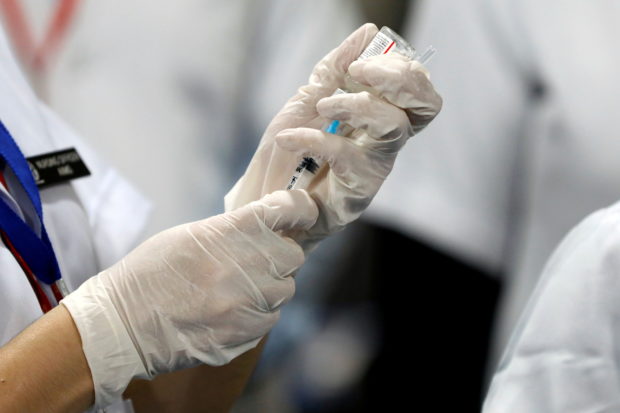61% of Filipinos OK with COVID vaccines; safety concerns still top reason for hesitancy
FILE PHOTO REUTERS/Adnan Abidi
MANILA, Philippines — As many as 61 percent of Filipinos are willing to get vaccinated against COVID-19 while 22 percent are still hesitant to get the shot, the latest study from analytics group OCTA Research showed.
In the study, OCTA said that of the 61 percent who see no problems about being vaccinated, 36 percent already got the anti-COVID-19 shots.
ADVERTISEMENT
However, for those who are not willing to be immunized, safety risks with the vaccines remain the top reason, with 65 percent of those unwilling to cite this issue.
“Sixty-one percent (61%) of adult Filipinos were willing to get vaccinated against Covid-19 during the survey period. This number includes the 36 % of adult Filipino who were already vaccinated and the 24% of respondents who are willing to get vaccinated,” OCTA Research said.
“On the other hand, twenty-two percent (22%) of adult Filipinos were not willing to be vaccinated during the survey period […] Uncertainty on the safety of vaccines is the top reason cited by 65 percent of adult Filipinos for not getting vaccinated against Covid-19,” it added.
Another 14 percent of those unwilling to be vaccinated cited questions on whether vaccines are effective, while nine percent of the respondents said that they have pre-existing conditions that would hinder vaccination.
In terms of areas, vaccine hesitancy is highest in the Visayas at 32 percent, followed by Balance Luzon at 24 percent, Mindanao at 19 percent, and the National Capital Region (NCR) at just five percent.
Coincidentally, the highest percentage of vaccinated individuals come from Metro Manila, with 76 percent of the respondents from this locale being fully vaccinated, while another nine percent got the first dose.
Compared to NCR, Mindanao had the second-highest vaccination rates, but it was a far second at 36 percent. Luzon followed it at 27 percent, and then the Visayas at 24 percent.
OCTA Research’s study, done using face-to-face interviews of 1,200 adult respondents from September 11 to 16, also showed that only three percent of Filipinos already vaccinated got infected with COVID-19.
“During the survey period, around 3 % of adult Filipinos contracted Covid-19 even after being fully vaccinated or completing their vaccine dosage. However, Balance Luzon has three times as much as the national average with 9 percent of adults contracting Covid-19 after full vaccination,” OCTA Research said.
ADVERTISEMENT
“On the other hand, 97% of fully vaccinated adult Filipinos did not report contracting the Covid-19 virus after completing their vaccine dosage,” it added.
The government’s vaccination program has continued to roll, even during the last surge in August and September due to the COVID-19 Delta variant. As of October 7, over 24.4 million Filipinos have been fully vaccinated against the pandemic, while the remainder of the 28.2 million individuals is first dose-receivers.
The latest data brings the total administered vaccines in the country to 52,783,354.
However, vaccine hesitancy is still a significant problem for the government. It is frustrating that President Rodrigo Duterte joked last October 12 that he would administer shots to those who reject it while asleep.
READ:
Fully vaccinated individuals vs COVID-19 now 24 million
READ:
Duterte on people hesitant to get COVID-19 shots: Vaccinate them while asleep
Subscribe to our daily newsletter
For more news about the novel coronavirus click
here.
What you need to know about Coronavirus.
For more information on COVID-19, call the DOH Hotline: (02) 86517800 local 1149/1150.
The Inquirer Foundation supports our healthcare frontliners and is still accepting cash donations to be deposited at Banco de Oro (BDO) current account #007960018860 or donate through PayMaya using this
link
.
Read Next
Negros Occidental prov’l employee fired for grave misconduct
EDITORS’ PICK
MOST READ
Don’t miss out on the latest news and information.
View comments



